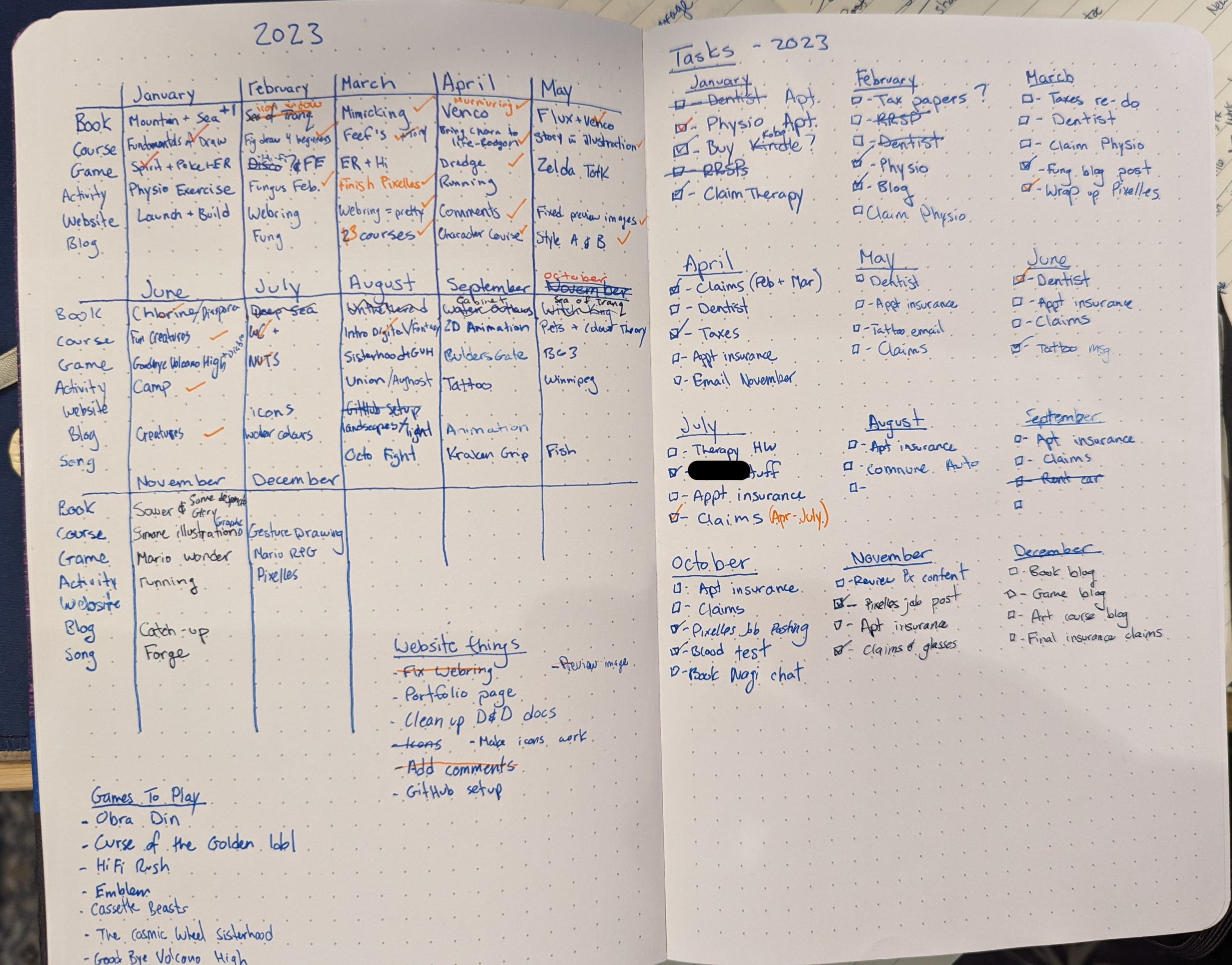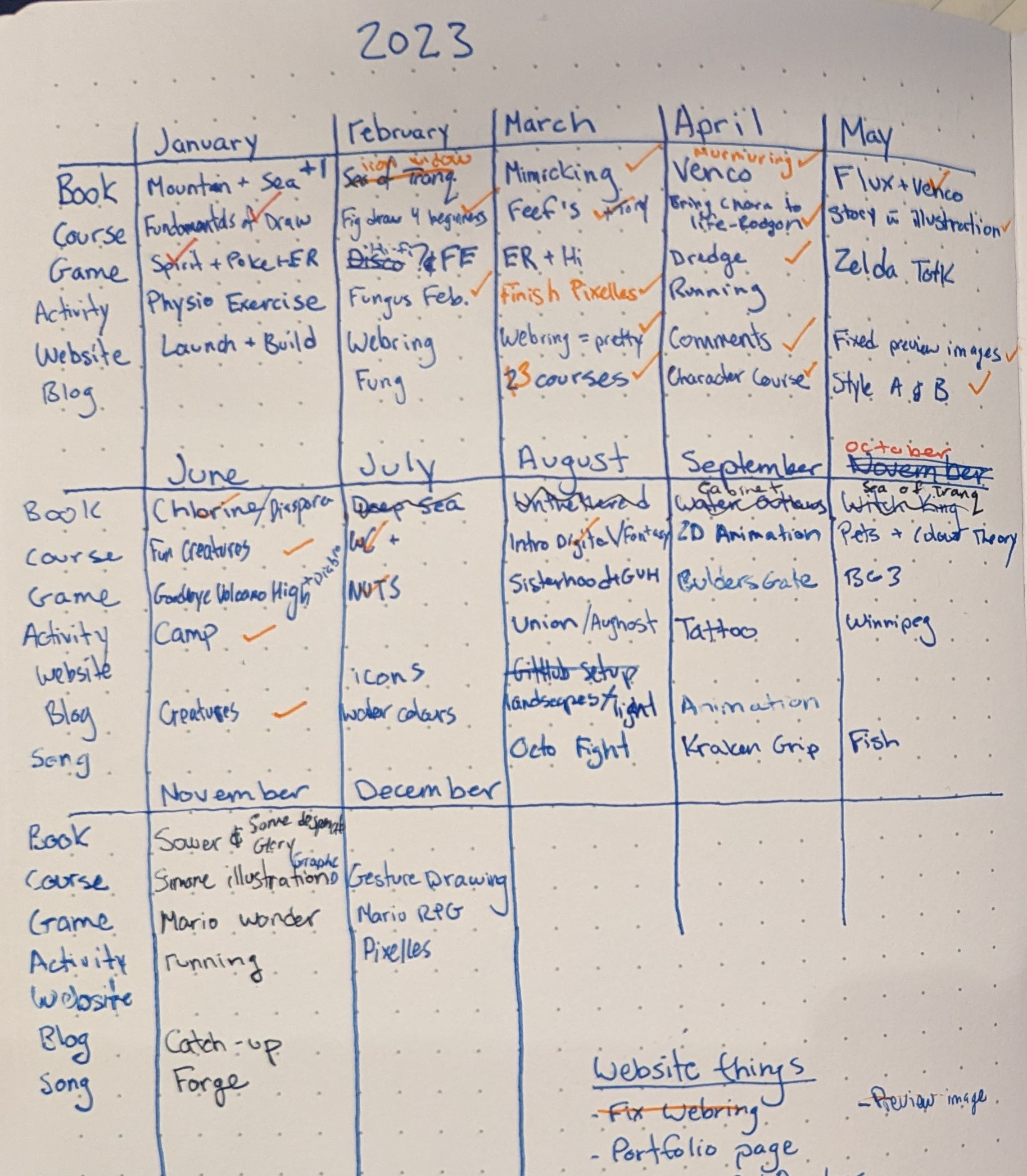Microjournaling aka hobby management
This end of year post is rather different from the reviews I’ve been writing. It’s more of a personal review of a journaling method I’ve been using this year to help manage multiple hobbies. If you are extremely minimalist while also loving to plan your life month by month, it could work for you too. But at the moment it’s extremely tailored to me of my kind-of hyper organised lifestyle.
This approach came about after multiple chats with my therapist of me complaining about how I have no time for hobbies and when I commit to one it feels like I lose the ability to stay interested in the rest. I often hyper focus on whatever activity currently has me in its grips. The other focus of this method was to help balance executive dysfunction when it comes to those “I would rather die” tasks. Things like phoning the doctor, filing medical papers, or chores that have been put off for months.
Origin
Even while being someone who loves to make a to-do list, I haven’t been a journaler since my early teens. Unless we still count LiveJournal, then my early 20s. Once I was done with school the habit died off even more.
The bullet journal fad came and went (still here?) and while I was enamoured with the accessories, washi tape, nice journals, nice pens. It wasn’t enough to get me to commit to keeping a journal.
But then I started therapy and I started to have more things to write down. I loved when my therapist would give me homework or a suggestion on an activity or emotion to chart. I liked being able to look back on progress while reminding myself that therapy was changing aspects of my life.
This never became anything huge but it meant I finally used some pages in my nice notebooks.
And then there was the pandemic. I was already unemployed when the lockdown part of the pandemic hit Montreal, and like many people I fell into a bit of a malaise. My regular hobbies couldn’t hold my attention, the world was falling apart and I spent hours doom scrolling. This became another thing to come up in therapy and the main suggestion I got was “even if you don’t feel like doing X will be relaxing, try doing X for 10 minutes”. The idea behind it was to give a hobby an honest try for a very small time commitment. If it wasn’t working I could move on to something else pretty quickly. But if it felt good then I was likely to stick with it for much longer (This is very familiar to how you approach building a regular practice!).
With that advice I made it through the major lockdown and a major life change, touching my hobbies from time to time but mostly letting them fall to the side. At the end of 2022 I felt like things had settled enough that I could give my hobbies another try. But I was ambitious, I didn’t want to get back into one hobby, I wanted to get back to most of them: drawing, reading, website development, and video games.
(Video games were the most sturdy hobby, that one never really fell off. The problem with it was that it has the most potential to over take my time and push the other hobbies out.)
And so with my previous experiences of to-do lists and methods of approaching hobbies, I made myself a single page journal.

The page
Single page maybe isn’t accurate. I used a single page to plan my hobbies over the course of the year, and one more page for dealing with responsibilities.
When I look at this I feel like I’ve taken bullet journaling to the next level. An approach that was already pretty minimal and now I reduced it even further.
For each month I would prioritise a little bit of each hobby: 1 book, 1 video game, 1 art course, 1 blog post, 1 website project, etc.

My idea behind this was that if I finished my game of the month, I would have to check off the other hobbies before returning to another new video game. This helped me to balance my free time between hobbies instead of just going to the easiest choice with my free time.
The one I do feel like I struggled with was reading. This is a hobby that can suck me in or turn me away. If I read a book I enjoy I’ll start another one quickly and then can often get a streak going. But if I read something less exciting it’s hard to get me to pick up a book for a few months. It was also a challenge because I was trying not to buy every book. I wanted to rely more on the library system. But this made it almost impossible to stick with my pre-planned reading list because most were new releases and the waiting list at the library for those could be months long.
Note for myself to take into next year: Just buy a book if I feel like reading it (if I’m still employed anyway). I buy most books digitally these days so it’s not like I need to worry about them taking up space.
Overall I loved this page. I loved checking things off, I loved being able to look at it to help me choose what hobby to work on, removing the indecisions of what exactly that hobby would be. If I wanted to read in August I’d check this page and I would prioritise reading what I had chosen way back in January.
Tasks
On the page next to this one I broke it down by months once again. But this time with a to-do list for every month. This one wasn’t filled out at the start of the year like the previous page. It was filled up as responsibilities would arise.
The main goal of this page was to 1 - keep myself focused on the more immediate responsibilities and 2 - stop me from feeling overwhelmed by responsibility.
It’s easy to make a big list for trying to stay on top of everything in life, but that list could potentially be endless. So these lists had to be the things I didn’t want to do but really needed to. Also I tried to limit every month to 5 things. You can do 5 things in a month.
Sometimes this helped to get those big things done early in the month. A quick checkoff to feel good about myself and then coast on free time for the rest. Some of the items you can see really dragged. Getting carried over to multiple months because I never got around to it (the list isn’t magical, lol).
There is still one major outstanding task I didn’t complete: buying renters insurance. It’s something I really should do but it has multiple steps and involves phoning a company. A herculean task. But I keep copying it over, it keeps being one of my 5 things. Someday it will get done.
Really this to-do list approach was about being kind to myself. While it was an act to focus on what I needed to get done, it helped me to know when I could turn off the guilt of not being responsible and just enjoy my time. And by limiting how many goals I would have for a month it rarely meant I had a month that would feel overwhelming.
And that’s microjournaling
I’m calling this microjournaling as it’s the smallest form of journaling I’ve tried. Smaller than a bullet?? It takes up one open page of a notebook and nothing else. It takes minimal effort to put together and works more as a reference or guide for making choices. I’m honestly super excited to fill out my page for next year. The only one I can usually fill in at the start is books because I have a huge backlog. For video games I check release dates and plan around those. The rest often get filled in as I find things I want to work on.
But a lot is still up to chance and where my interest takes me. It probably looks super rigid when shown like this, but I still felt like I had freedom to pursue my interests while feeling focused.
